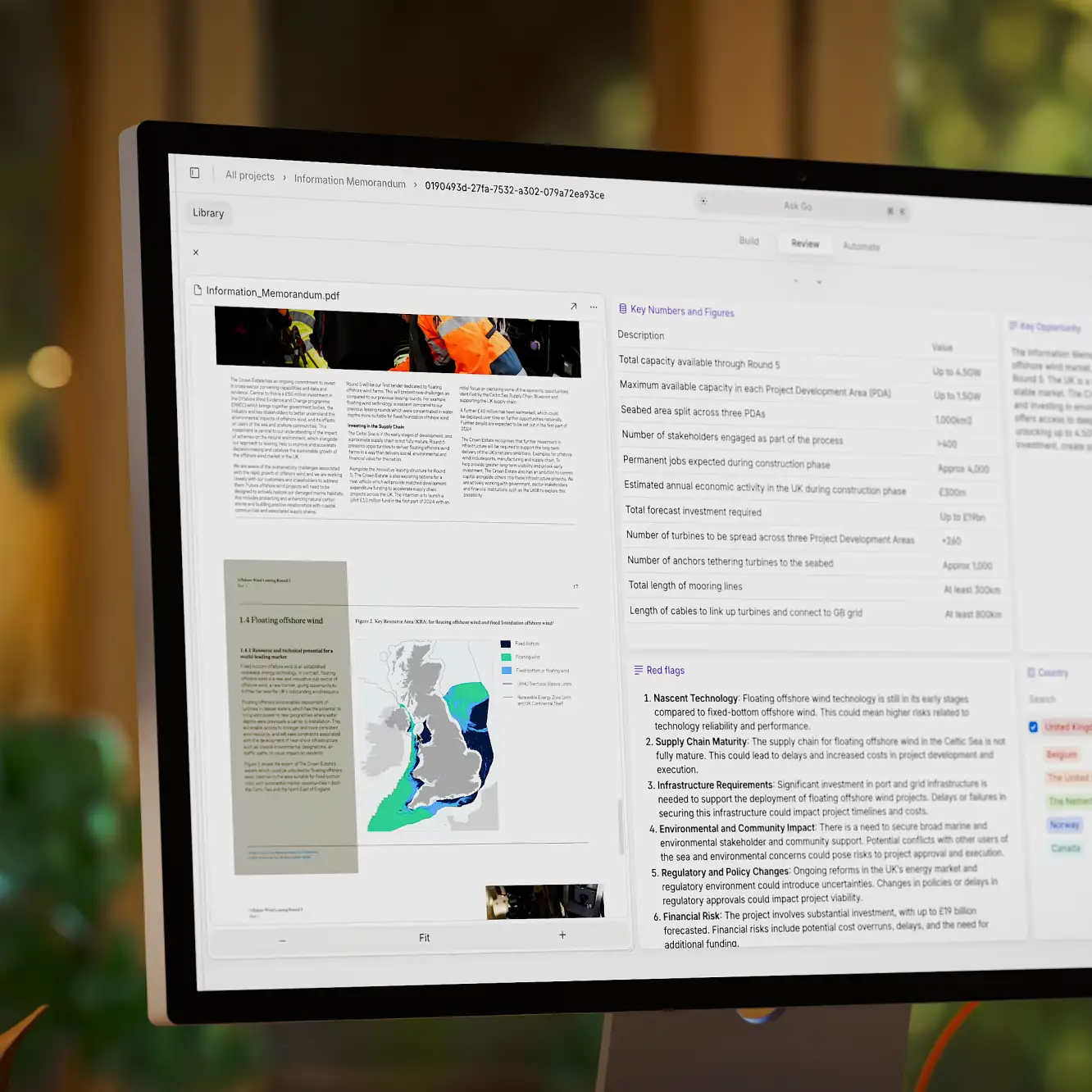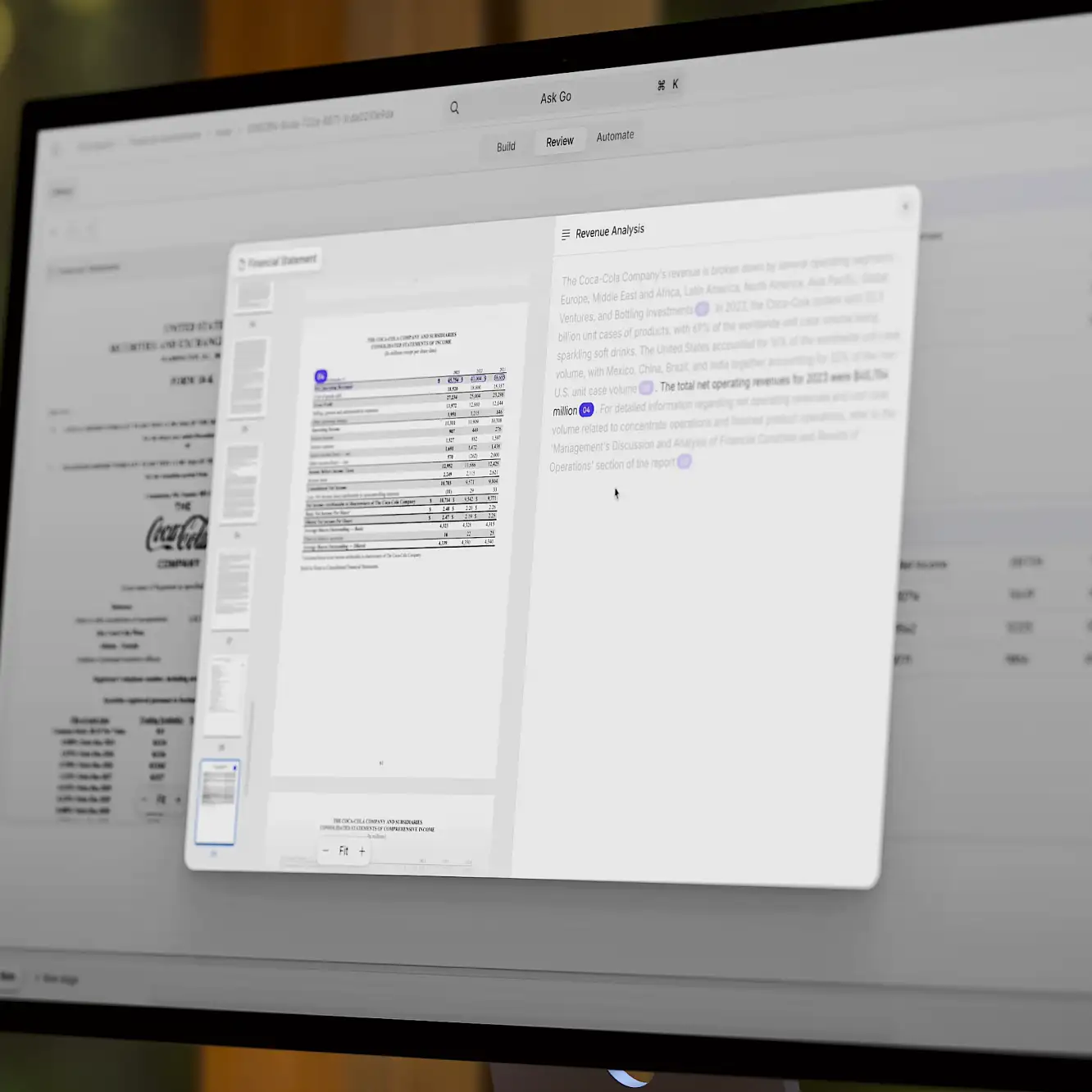Document processing
10 best data extraction tools powered by AI [2024]
14 min read
—
Jun 26, 2024
Explore the best tools that will help you eliminate manual data entry errors and improve your operational efficiency with AI.

Content Creator
In the data-driven business reality of 2024, extracting information from various sources and documents with AI is not just a competitive advantage—it's a necessity.
Just think about it—
Manual data entry is costly, requires effort, and still needs complex quality control processes set in place.
It is no wonder that AI-powered data extraction tools have revolutionized the landscape. Businesses now use them to handle data in ways that are faster, more accurate, and cost-effective. These advancements have far-reaching implications, enabling organizations to operate with unprecedented efficiency and agility.
In this article, we’ll explore the top 10 AI-driven data extraction tools available in 2024, highlighting their impact on modern enterprises.
Best data extraction software powered by AI:
V7 Go. Document and web AI data extraction and task automation tool
Mindee. AI-powered document processing platform
Nanonets. Custom machine learning models for data extraction
Octoparse. No-code web scraping and data extraction tool
Import.io. Visual web scraping and API creation platform
Rossum. AI-powered document processing and OCR
Hevo Data. No-code, real-time data integration platform
Apify. Comprehensive web scraping and automation platform
Bright Data. All-in-one platform for proxies and web scraping
Diffbot. AI-powered data extraction and knowledge graph platform
Before we delve into reviewing and comparing these solutions, let’s go through some key aspects related to the topics of data extraction and data parsing.
What is a data extraction tool?
A data extraction tool is a software solution designed to retrieve specific data from diverse sources, including documents, databases, and websites. This type of software uses advanced AI algorithms to automate the extraction process. Ultimately, the goal is to ensure high accuracy and operational efficiency.
According to a report by IBM, about 65% of global businesses single out reducing repetitive manual tasks as their primary reason for AI adoption. And, document processing or data extraction are perfect examples of tasks that don’t have to be done manually.
For example, an AI document processing platform can classify documents and, based on their type, identify information to extract or even summarize content. Then, it can cross-reference this information with other documents, such as policy guidelines, legal documents, or additional instructions.
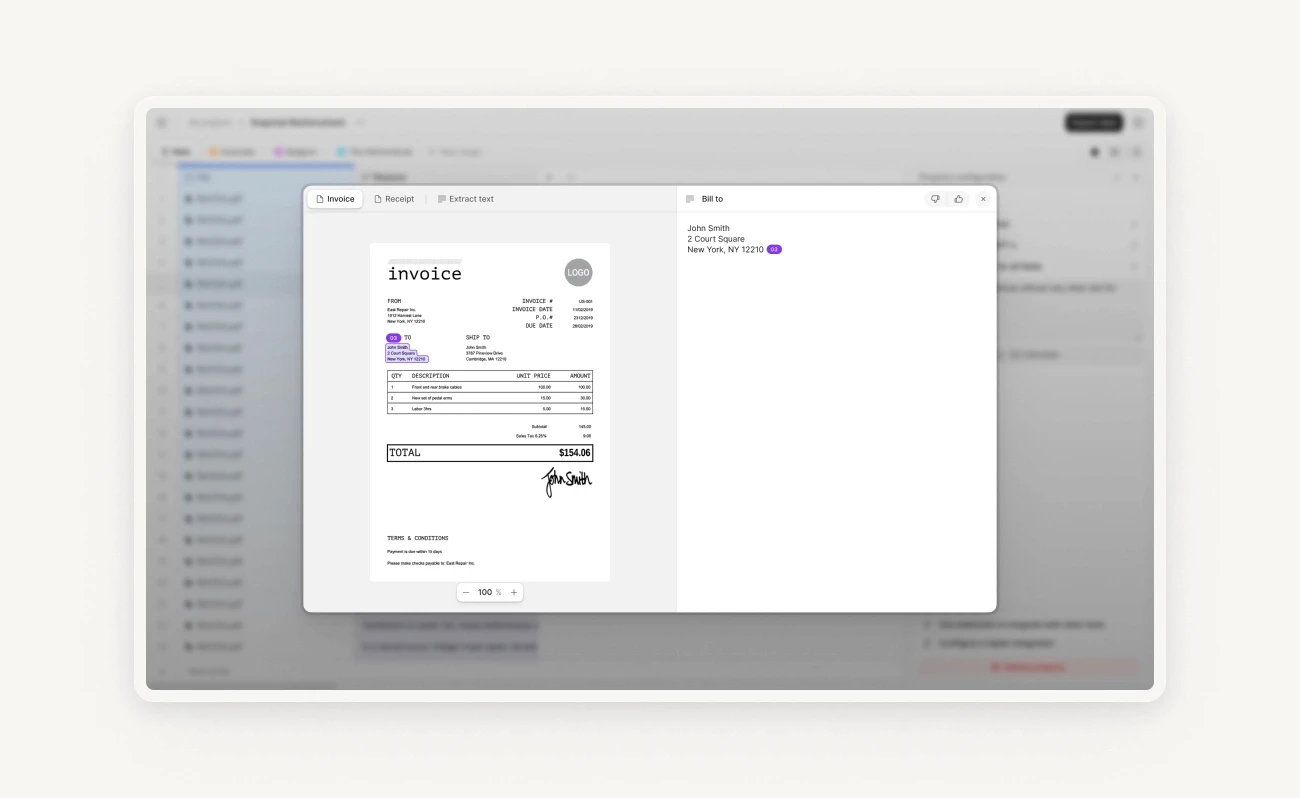
Finally, an AI-powered data extraction tool can detect discrepancies and route difficult cases for human review, with specific areas of a PDF file highlighted (this functionality is called “visual grounding”) for easier inspection.
Key use cases and benefits
Data extraction tools are extremely relevant across all industries that process documents, from finance and healthcare to retail and logistics. A survey by Amazon suggests that over 90% of organizations in the United States expect to use AI-powered solutions within the next three years.
Here are some critical applications:
Invoice processing. Automating the extraction of data from invoices to streamline accounting workflows.
Customer data management. Collecting and organizing customer data from multiple touchpoints for enhanced customer insights.
Web scraping. Gathering data from websites for market research, sentiment analysis, and competitive intelligence.
KYC processes. Extracting data from identification documents to streamline customer onboarding and compliance processes.
Claims processing. Automating the extraction of information from insurance claims to speed up verification and settlement processes.
Contract analysis. Extracting and organizing key terms and clauses from legal contracts to facilitate compliance and risk management.
Medical records management. Digitizing and extracting patient data from medical records to enhance healthcare delivery and patient management.
Supply chain documentation. Automating the extraction of data from shipping and delivery documents to improve logistics and inventory management.
The benefits of using these tools are substantial:
Speed. AI-driven tools can reduce data processing times and accelerate decision-making and operational workflows.
Accuracy. By minimizing manual entry errors, businesses can ensure higher data quality.
Cost savings. Companies can lower operational costs and relocate resources to more strategic initiatives
AI data extraction vs. OCR
While OCR (Optical Character Recognition) technology has been instrumental in converting various document types into editable and searchable data, AI data extraction goes several steps further. Beyond mere text recognition, AI data extraction tools understand the context, extract relevant information, and organize it for specific use cases. This context-aware extraction is crucial for handling complex documents and unstructured data sources.
In the video above you can see an AI data extraction platform that analyzes and classifies different types of IDs and performs additional operations, like checking whether the IDs are still valid.
How data extraction works
AI data extraction tools leverage a range of advanced technologies to process unstructured inputs through several steps:
Optical Character Recognition (OCR). Converting different types of documents, such as printed or handwritten text, into machine-readable data, which can then be analyzed and structured by AI algorithms.
Natural Language Processing (NLP). Analyzing and interpreting text to understand context and semantics, allowing for more accurate extraction of relevant information.
Retrieval-Augmented Generation (RAG). A retrieval system first identifies relevant documents or passages, and then a generative model (like a transformer-based language model) processes this information to generate more accurate and contextually appropriate responses or data.
Key data point identification. Utilizing large language models (LLMs) like ChatGPT to identify and extract essential data points and relationships within the text, ensuring comprehensive data capture.
Multimodal AI. Combining text analysis with image analysis to process and extract data from various types of inputs, such as scanned documents, images, and PDFs, enhancing the scope and accuracy of data extraction.
Data structuring/parsing tool. Converting unstructured data into structured formats suitable for analysis and reporting, ensuring that the extracted data is organized and easily accessible for further use.
Visual grounding. Highlighting specific areas within documents, such as PDFs, to provide visual context for the extracted data, aiding in the identification of discrepancies and facilitating human review when necessary.
These integrated technologies enable AI data extraction tools to handle complex, unstructured data sources with unprecedented efficiency and accuracy.
What are the different types of data extraction software?
Data extraction software can be categorized into different types based on their applicability, industry, or technologies used. However, we are gradually entering the stage where all-in-one platforms can address any use case you can think of with multimodal AI. Some solutions can even break your problem into a set of smaller sub-tasks and design the whole workflow on their own.
However, here is the traditional breakdown of data extraction software, in case you want to focus on a specific use case:
Document data extraction
Extracts critical information from documents such as legal contracts, compliance reports, and IDs. This type of software is essential for automating administrative tasks and improving data accuracy.
Database extraction software
Directly pulls data from databases, ensuring that data is readily available for analysis and reporting. This software is crucial for maintaining up-to-date and accurate data warehouses.
Financial data extraction
Specialized in processing financial documents such as invoices, receipts, and transaction records. It helps in automating financial reporting and compliance processes.
Web data extraction
Scrapes data from websites for various purposes, including market research, sentiment analysis, and competitive intelligence. This type of software is vital for businesses that rely on real-time data from online sources.
OCR software
Recognizes and converts different types of documents into editable and searchable data. While OCR is a core functionality for doc processing, the integration of AI enhances its capabilities, making it possible to handle more complex data extraction tasks.
Best AI data extraction tools
The comprehensive list below showcases the top automated data extraction and document processing software solutions. From powerful web scraping engines to advanced optical character recognition capabilities, these cutting-edge tools will equip you with the essential arsenal to extract structured and unstructured data from virtually any source.
1. V7 Go: AI data extraction & workflow automation tool
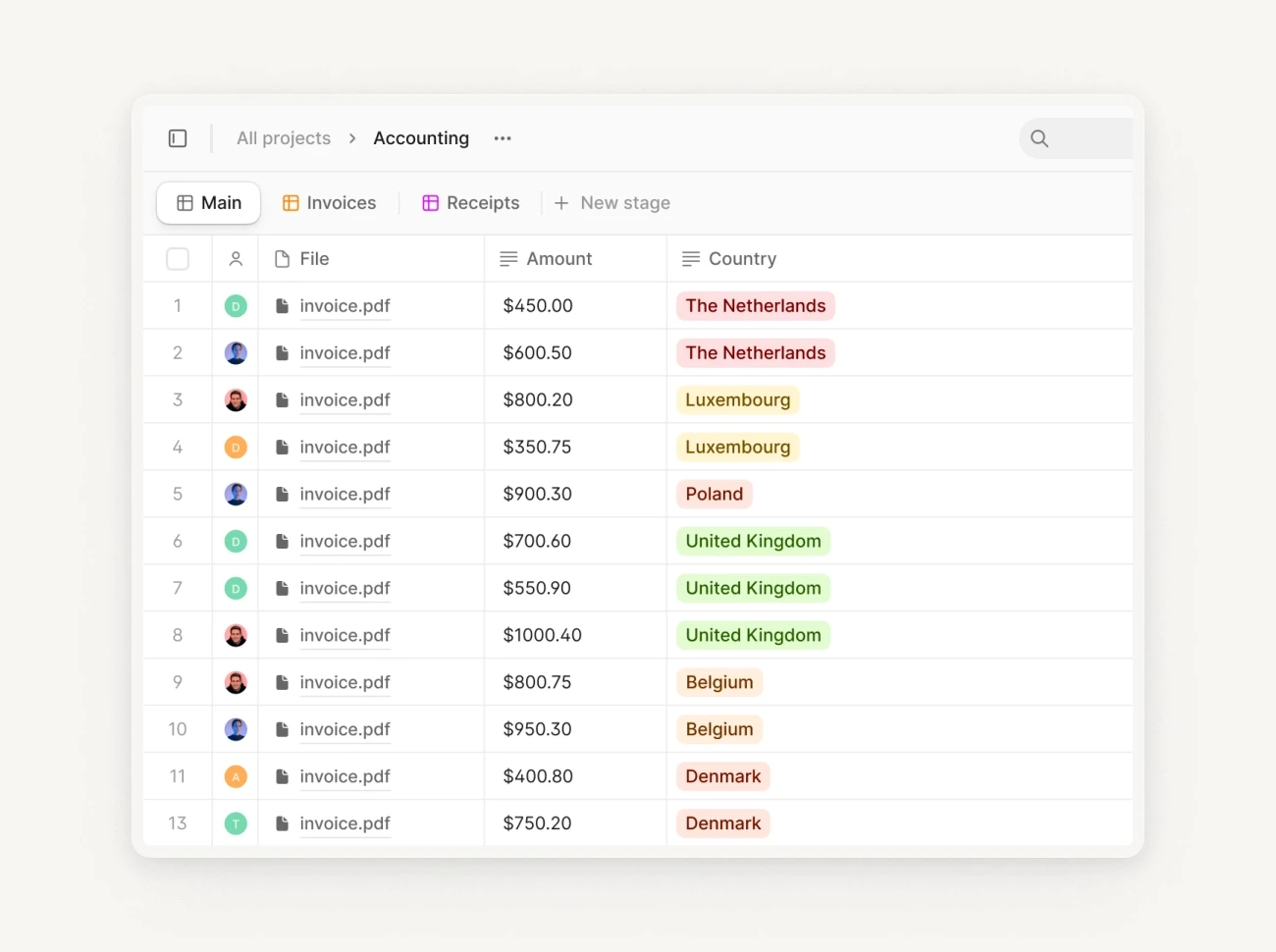
V7 Go is an advanced AI platform designed to automate and streamline file, document processing, and web scraping tasks. It is an all-in-one toolkit that can help you turn any unstructured input into a structured output and perform multi-step reasoning tasks on the results. The platform is highly praised by users for its accuracy. V7 Go aims to enhance user experience and streamline workflows for businesses in sectors such as fintech, HR, and accounting.
The tool made quite a splash and is attracting a lot of positive attention recently.
V7 Go excels at AI workflows that extract, analyze, and process information, making it a powerful tool for businesses seeking to reduce manual effort and improve efficiency in data handling.
Key Features of V7 Go:
Implicit Optical Character Recognition. V7 Go utilizes advanced OCR technology to accurately recognize and extract text from both printed and handwritten documents, enhancing data accuracy and processing speed.
Generative AI workflows. Automates complex tasks across multiple data types, significantly reducing the time spent on repetitive tasks.
Human-in-the-loop QA. Allows for human corrections and reviews in the AI workflow, enhancing the reliability and accuracy of automated processes.
Index Knowledge. Breaks down large files into searchable indexes, enabling more accurate information retrieval.
Pros:
Ease of use. The intuitive interface and straightforward setup process make it accessible to users without extensive technical knowledge.
Custom automations. V7 Go's ability to automate a wide range of tasks and design custom workflows helps businesses save significant time and resources.
Excellent support. The responsive and helpful customer support team ensures smooth onboarding and efficient fixes.
Cons:
Large documents can use your free token allowance quite quickly. It is best to set up a correct workflow and test it on smaller PDFs or CSVs first.
V7 Go is ideal for companies handling vast amounts of data, offering great accuracy rates, ease of use, and comprehensive automation capabilities. The platform’s robust features make it a key asset for improving operational efficiency. If you need a data extraction all-rounder, V7 is the go to solution.
Pricing:
V7 Go is available through flexible, usage-based plans tailored to your document workflows. You can book a demo to see it in action, and if your use case is a good fit, we’ll deliver a free proof of concept using your sample documents—usually within a few days.
2. Mindee: AI document processing platform

Mindee provides advanced AI-powered APIs for developers to transform documents and images into machine-readable data quickly and accurately. Their solutions include OCR for various document types such as receipts, invoices, passports, and identity documents. Mindee's technology leverages deep learning to ensure fast, real-time data extraction.
Despite its technical prowess, it presents a learning curve and is geared more towards developers than casual users. Some customers highlight its ease of integration and high accuracy, but note limitations for non-technical users.
Pricing:
Mindee offers a free version and a scalable pay-as-you-go model for more extensive needs.
3. Nanonets: AI doc processing and data capture solution
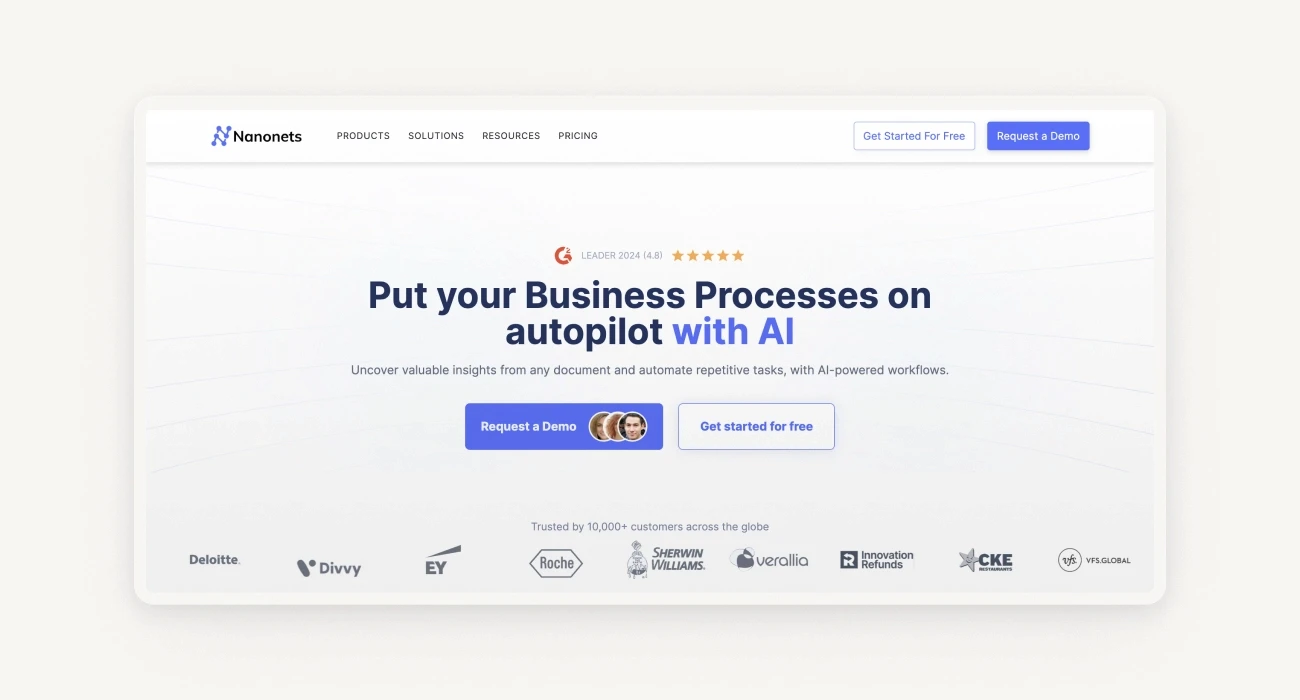
Nanonets offers AI-powered solutions to automate business processes by extracting and processing data from various document types, such as invoices, receipts, and ID cards. Their platform enables seamless data extraction, enrichment, and integration with other systems, helping businesses in finance, healthcare, and manufacturing to streamline workflows, reduce manual effort, and enhance decision-making.
Nanonets' no-code platform allows for quick setup and customization, supporting the automation of complex tasks with high accuracy.
Pricing:
Nanonets provides a free trial, with a basic plan starting at $499/month, making it suitable for businesses that handle large volumes of documents and require precise data extraction.
4. Octoparse: web scraping and data extraction tool
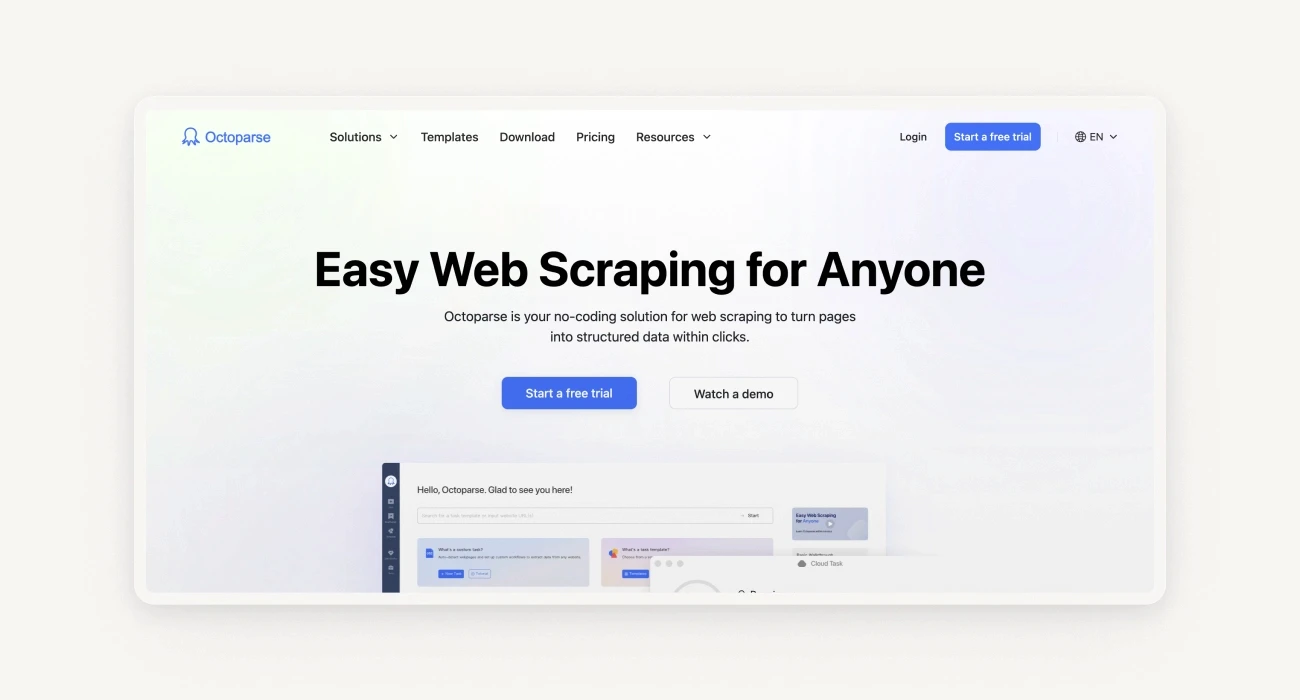
Octoparse provides a no-code web scraping platform that enables users to extract structured data from websites efficiently. It offers features such as AI-powered auto-detection, a visual workflow designer, IP rotation, CAPTCHA solving, and cloud-based automation. Users can create custom scrapers or use preset templates for popular websites, facilitating data collection for various industries like e-commerce, lead generation, and content curation.
While praised for its user-friendly interface and comprehensive features, it occasionally faces performance issues on complex, bot-protected websites.
Pricing:
Octoparse is available for free with limited features, with a more advanced standard plan starting at $75/month, ideal for users needing robust web scraping capabilities without technical expertise.
5. Import.io: web data extraction solution
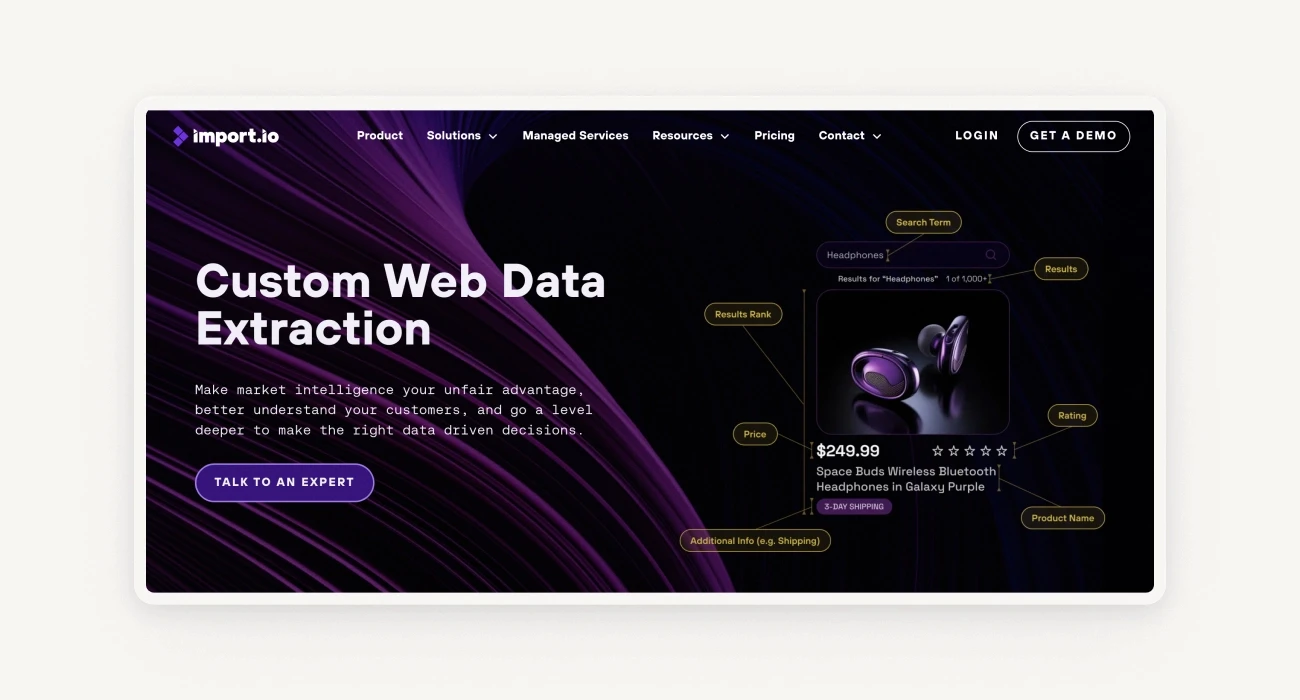
Import.io provides a platform for web data extraction, enabling businesses to gather, process, and utilize large volumes of data from websites efficiently. Their AI-driven tools and managed services support various industries, including e-commerce, travel, and market research, by transforming web data into actionable insights. This allows companies to make data-driven decisions, enhance market intelligence, and improve operational efficiency.
This platform supports large-scale data extraction tasks and complex data manipulation, catering to businesses involved in market research and digital marketing. While it offers powerful data extraction and transformation tools, it can be expensive.
Pricing:
Import.io allows new users to start with a free trial, and its Essential plan begins at $299/month, providing a comprehensive toolset for extensive web data operations.
6. Rossum: AI financial document processing
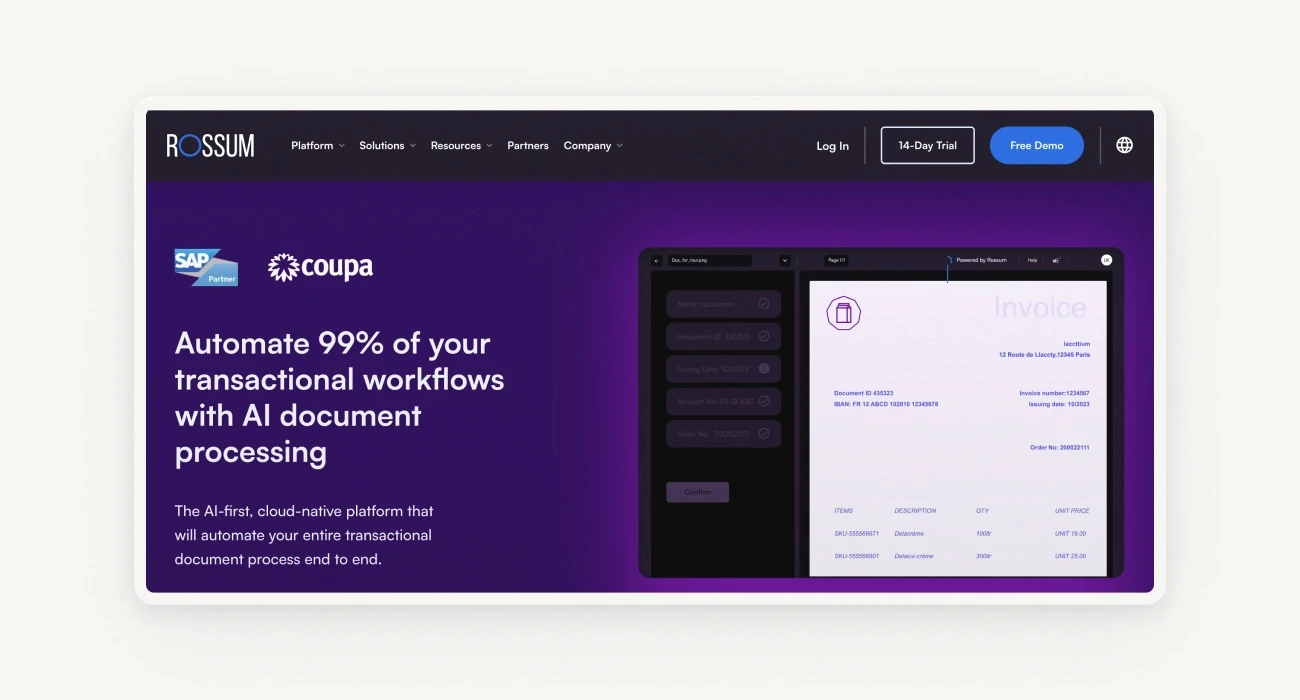
Rossum provides an AI-driven platform for automating the processing of transactional documents. Their cloud-native solution uses advanced AI to extract, validate, and manage data from documents like invoices and purchase orders, significantly reducing manual workload and increasing efficiency. The platform adapts to various document layouts without requiring new templates and integrates seamlessly with existing systems. Businesses across industries such as finance, logistics, and retail use Rossum to enhance their document processing workflows.
Pricing:
Rossum provides a free trial, with an Essential plan starting at $299/month, aimed at businesses needing efficient, scalable document processing solutions.
7. Hevo Data: no-code data integration platform
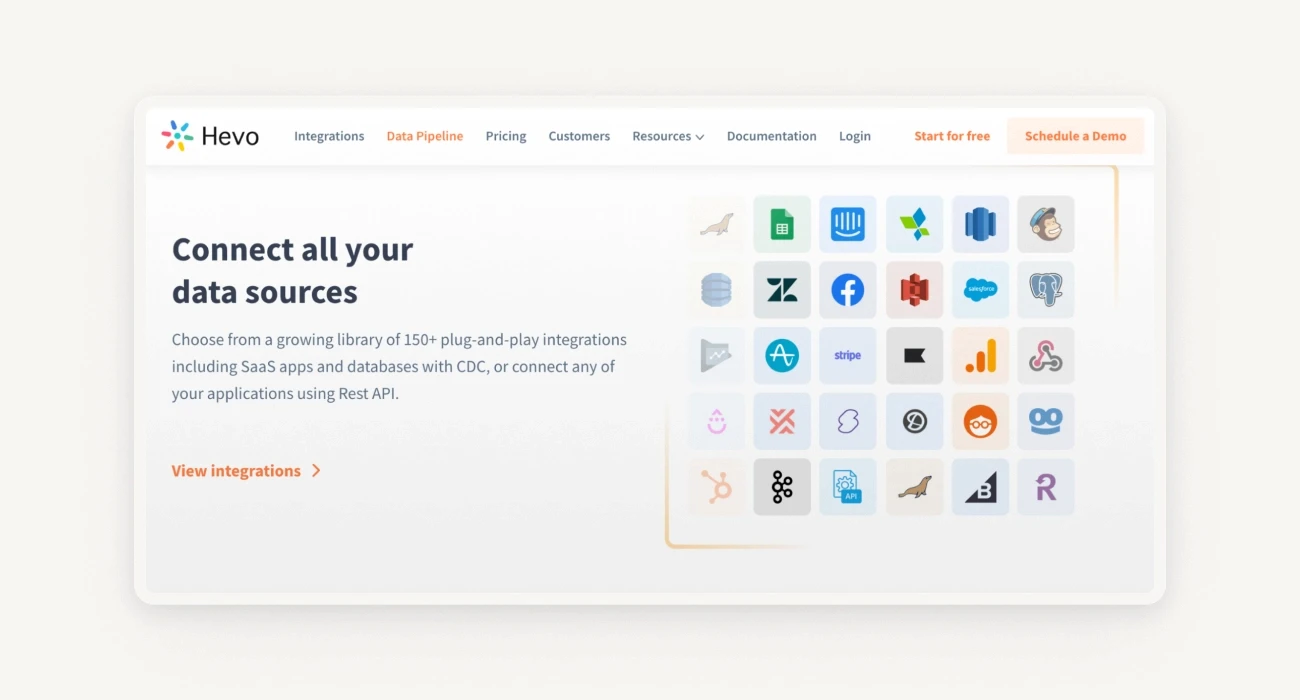
Hevo Data offers a no-code data pipeline platform that allows businesses to integrate, transform, and synchronize data from multiple sources into data warehouses in real-time. The platform can pull data from over 150 different sources, including databases, cloud applications, and more. This extracted data is then transformed and integrated into data warehouses or other destinations in real-time. Hevo Data's platform is designed to be easy to use, secure, and scalable, catering to various industries to improve data-driven decision-making and operational efficiency.
Pricing:
Hevo Data offers a free trial, with pricing starting at $239/month, making it attractive for businesses seeking straightforward, effective data integration tools without deep technical knowledge.
8. Apify: web scraping and automation software
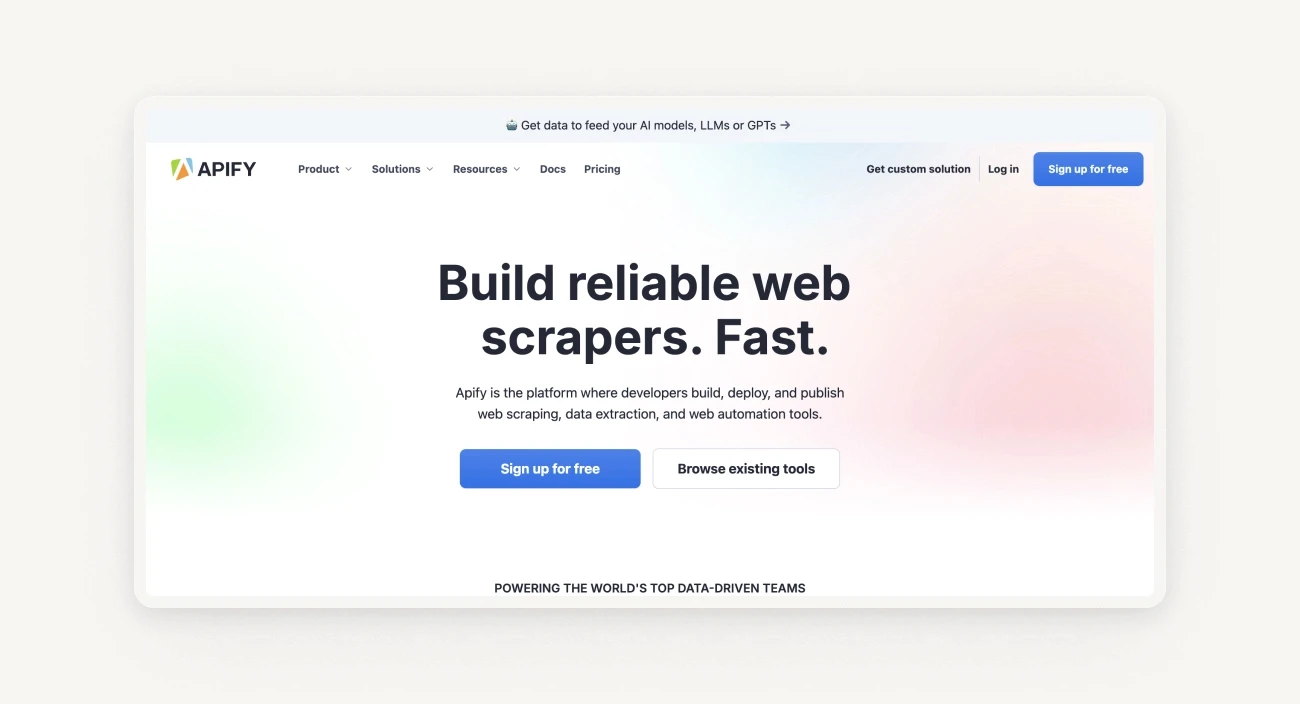
Apify provides a full-stack platform for web scraping, data extraction, and web automation. It enables developers to build, deploy, and manage web scrapers and automation tools using a range of open-source libraries and APIs. Apify also offers cloud-based services, including proxies and data storage, to support scalable and efficient data collection. Their platform caters to various use cases, from market research to machine learning data preparation.
Apify supports complex data extraction tasks with features like JavaScript rendering and IP rotation. While it provides flexibility and robust customer support, the learning curve can be steep for non-developers.
Pricing:
Apify offers a free basic plan and a more feature-rich Personal plan starting at $49/month, catering to users with varying levels of technical skills engaged in data-driven projects.
9. Bright Data: all-in-one platform for proxies and web scraping
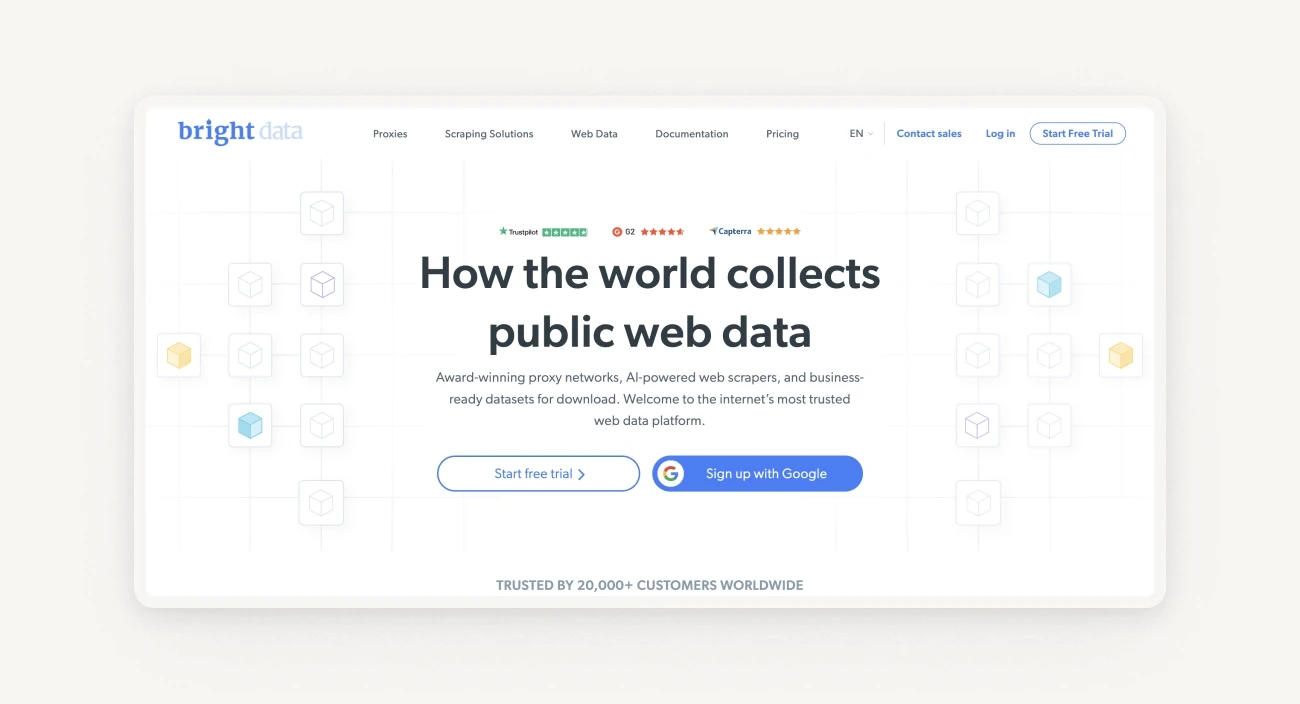
Bright Data provides a comprehensive platform for web data extraction, offering services such as proxy networks, web scraping tools, and ready-to-use datasets. Their solutions include residential, mobile, and datacenter proxies, as well as APIs for scraping search engines and bypassing web protections like CAPTCHAs. Businesses use Bright Data to gather public web data for market research, competitive intelligence, and various other applications, ensuring ethical and compliant data collection practices.
Despite its effectiveness, the platform can be complex to set up and requires some familiarity with proxy services.
Pricing:
Bright Data provides a free trial with custom pricing available, ideal for businesses that need a powerful, comprehensive data collection and management solution.
10. Diffbot: AI-powered data extraction and knowledge graph platform
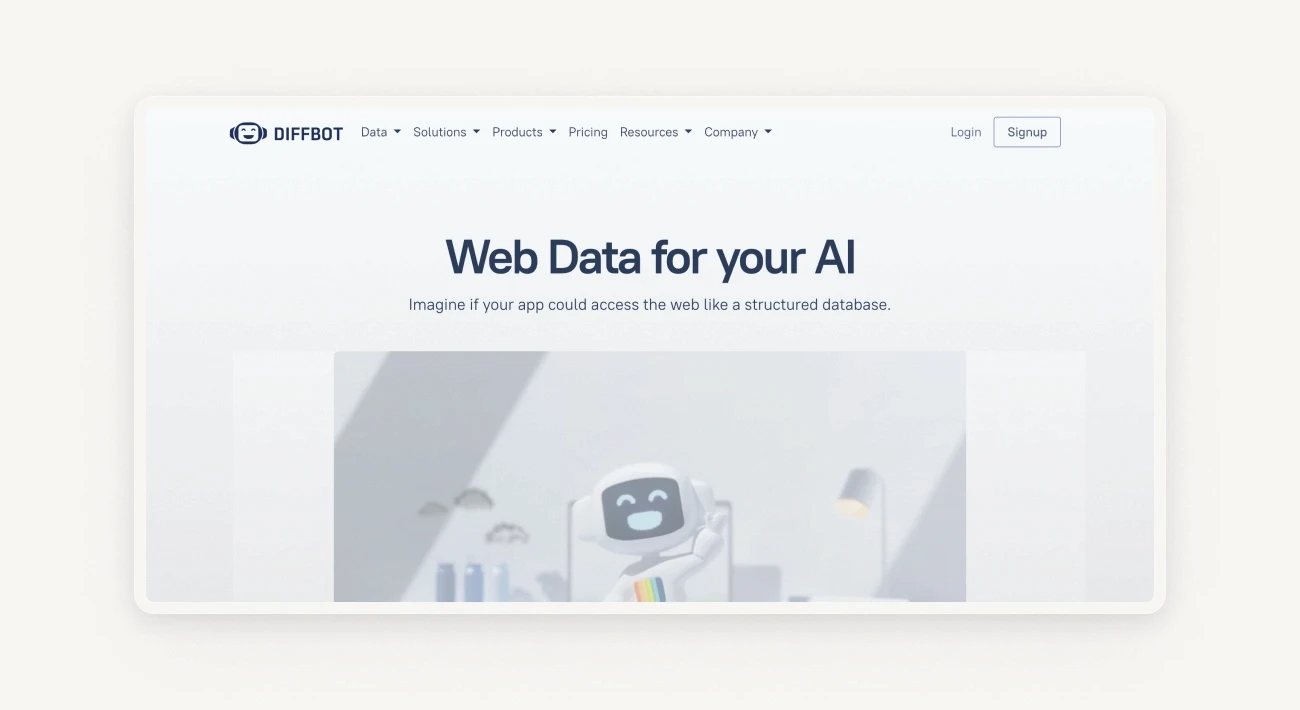
Diffbot provides AI-powered tools for web data extraction and natural language processing. Their platform includes products like Extract for analyzing web content, Crawl for transforming websites into structured databases, and a Knowledge Graph that compiles and enriches data on entities such as organizations, articles, and products. Diffbot’s solutions are used for market intelligence, news monitoring, and enhancing datasets with accurate web-sourced information.
While praised for its scalability and support, Diffbot focuses on website data extraction and does not support PDF documents.
Pricing:
Diffbot offers a free trial with custom pricing, tailored to businesses requiring extensive, reliable web data extraction and analysis capabilities.
Conclusion
The evolution of AI-powered data extraction tools has significantly altered business operations. By automating and refining data collection processes, these tools not only enhance efficiency but also open new avenues for data-driven decision-making. As we move further into the digital age, the ability to swiftly and accurately extract data will continue to be a competitive advantage. Embrace the future of data extraction and see how these tools can transform your business operations today.
Further reading:

